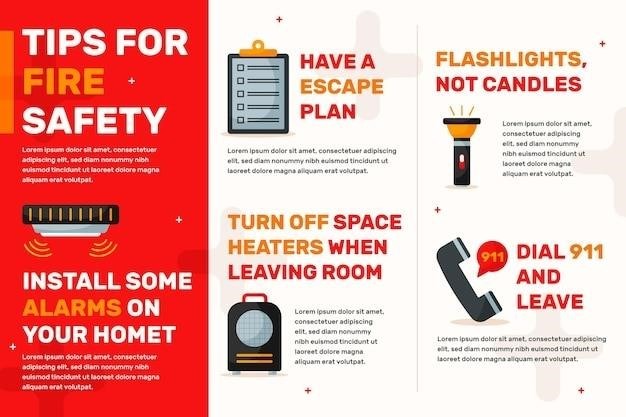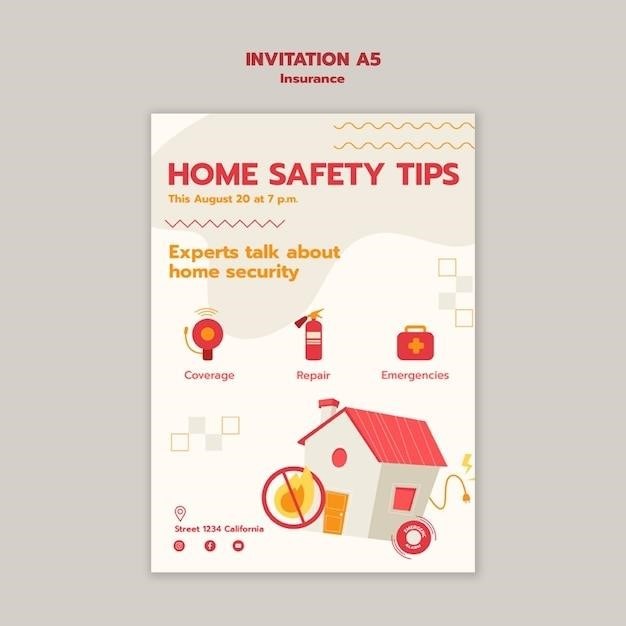
Kidde Smoke and CO Alarm Manual⁚ A Comprehensive Guide
This comprehensive guide provides essential information on Kidde smoke and carbon monoxide alarms, covering everything from model identification and safety instructions to troubleshooting common issues and important safety information. Whether you’re a homeowner looking to install a new alarm or a seasoned user seeking guidance on maintenance and operation, this manual will equip you with the knowledge you need to ensure the safety of your home and family.

Introduction
Kidde smoke and carbon monoxide alarms are vital safety devices designed to protect your home and loved ones from the dangers of fire and carbon monoxide poisoning. This manual serves as your comprehensive guide to understanding, installing, operating, and maintaining your Kidde alarm. From identifying your model and learning about its features to troubleshooting common issues and staying informed about important safety practices, this manual will empower you to use your alarm effectively and ensure its optimal performance.
Understanding Your Kidde Smoke and CO Alarm
Your Kidde smoke and carbon monoxide alarm is a crucial part of your home safety system, designed to detect both smoke and carbon monoxide, invisible gases that can be deadly. It utilizes advanced technology to provide early warning, giving you precious time to evacuate your home and seek safety in case of a fire or carbon monoxide buildup. Understanding the features, operation, and maintenance of your alarm is essential for maximizing its effectiveness and ensuring the safety of your family.
Model Identification
Identifying your Kidde smoke and CO alarm model is essential for accessing the correct user manual and troubleshooting information. The model number is typically found on a label located on the back of the alarm. To locate it, you’ll need to remove the alarm from the ceiling or wall. Most alarms are attached to a mounting plate and can be removed by turning the alarm counterclockwise. Refer to the alarm removal instructions provided in your user manual for specific steps.
Alarm Features
Kidde smoke and CO alarms offer a range of features designed to enhance safety and provide peace of mind. These features may include a loud, piercing alarm sound to alert you to danger, a visual indicator light to signal alarm activation, a test button for regular functionality checks, a hush button to temporarily silence nuisance alarms, and a low battery indicator to remind you when the alarm needs new batteries. The specific features available will vary depending on the model of your alarm. Consult your user manual for a detailed list of features and their operation.
Safety Instructions
For optimal safety and performance, adhere to these crucial instructions⁚ Always install your Kidde smoke and CO alarm according to the manufacturer’s guidelines. Avoid placing alarms near sources of heat, steam, or dust, as these can affect their functionality. Regularly test your alarms to ensure they are working properly. Never tamper with or disable your alarms. In case of a fire or carbon monoxide emergency, evacuate your home immediately and call the fire department. By following these safety instructions, you can maximize the protection provided by your Kidde alarm.
Installation and Placement
Proper installation and placement are crucial for ensuring the effectiveness of your Kidde smoke and CO alarm; Choose locations that are easily accessible for testing and maintenance, but avoid areas prone to excessive dust, heat, or moisture. Install the alarm on the ceiling or high on a wall in each bedroom, hallway, and living area. For optimal coverage, follow the manufacturer’s recommendations for placement distances between alarms. Remember, the alarm should be at least 10 feet away from cooking appliances and fireplaces.
Operation and Maintenance
Regular maintenance is essential to ensure your Kidde smoke and CO alarm operates reliably. Test your alarm monthly by pressing the test button, ensuring it produces a loud, clear sound. Replace the battery at least once a year, even if the alarm doesn’t signal a low battery. For alarms with a sealed battery, replace the entire unit after the manufacturer’s recommended lifespan, typically 10 years. Clean the alarm’s exterior with a damp cloth to remove dust and debris, but never use harsh chemicals or abrasive cleaners. These simple steps will help maintain your alarm’s functionality and provide you with peace of mind.
Testing Your Alarm
Regularly testing your Kidde smoke and CO alarm is crucial for ensuring its proper functionality. Press the test button located on the alarm’s front panel. A loud, piercing sound should be emitted, indicating the alarm is working. If you do not hear a sound, or if the alarm’s sound is weak or distorted, troubleshoot the issue immediately. Testing your alarm monthly allows you to catch any potential problems before a real emergency occurs, giving you the best chance of a safe evacuation.
Battery Replacement
Replacing the batteries in your Kidde smoke and CO alarm is essential for maintaining its functionality. Follow the instructions provided in your alarm’s manual to access the battery compartment. Remove the old batteries and insert new ones, ensuring correct polarity. After installing fresh batteries, test the alarm to confirm it is functioning correctly. It’s also important to note the expiration date of your batteries and replace them well before they reach the end of their lifespan. Regular battery replacement ensures your alarm is always ready to protect you in case of an emergency.
Cleaning and Maintenance
Regular cleaning and maintenance are crucial for ensuring your Kidde smoke and CO alarm operates optimally. To clean the alarm, disconnect the power source and gently wipe the exterior with a damp cloth. Avoid using harsh chemicals or abrasive cleaners. For dust accumulation, use a vacuum cleaner with a brush attachment. Periodically check the alarm for any signs of damage or obstruction. If you notice any issues, consult your user manual or contact Kidde customer support for assistance. By following these simple steps, you can ensure your alarm remains in top condition, providing reliable protection for your home and family.
Troubleshooting Common Issues
While Kidde smoke and CO alarms are designed for reliability, occasional issues may arise. If your alarm is beeping, check the battery level and ensure it’s properly installed. A blinking red LED light could indicate a low battery, a unit error, or the end of the alarm’s lifespan. For other problems, consult your user manual for troubleshooting steps. If you’re unable to resolve the issue, contact Kidde customer support for assistance. Remember, addressing any problems promptly ensures your alarm functions correctly, providing vital protection for your home and family.
Alarm Beeping
A beeping Kidde smoke or CO alarm is a signal that requires your attention. The most common reason for beeping is a low battery. First, check the battery level and ensure it’s properly installed. If the battery is fine, the alarm might be experiencing a unit error. To reset the alarm, press and hold the test/reset button for about 5 seconds or more to quiet the beeping. If the beeping persists, consult your user manual or contact Kidde customer support for further assistance.
LED Indicator Lights
Kidde smoke and CO alarms often utilize LED indicator lights to provide visual cues about their status. A blinking red LED usually indicates a variety of situations, including a low battery, a unit error, or the alarm being activated. A steady green LED typically signifies that the alarm is functioning correctly and powered. Refer to your alarm’s specific user manual for detailed interpretations of LED patterns and colors. If you’re unsure about what a particular light sequence means, it’s best to consult the manual or contact Kidde customer support.
Other Problems
Beyond beeping and LED issues, other problems might arise with your Kidde smoke and CO alarm. If the alarm fails to activate during a test, it might indicate a malfunction. Additionally, a persistent “chirping” sound could signify a wiring problem or a faulty internal component. If you encounter any unusual behaviors or suspect a malfunction, it’s crucial to consult the user manual or contact Kidde customer support. They can provide guidance on troubleshooting or recommend a replacement if necessary.
Important Safety Information
Your Kidde smoke and CO alarm is a vital safety device, but it’s essential to understand its limitations and follow safety guidelines. This alarm is designed to detect smoke and carbon monoxide from common sources in residential settings. It’s not a substitute for comprehensive fire safety plans or professional inspections. Regularly test your alarm, maintain it according to the manufacturer’s instructions, and familiarize yourself with evacuation procedures in case of a fire or CO emergency. Remember that early detection and prompt action are crucial for protecting your family’s safety.
Fire Safety Tips
To maximize your home’s fire safety, consider these essential tips. Install smoke alarms on every level of your home, especially near bedrooms and sleeping areas. Keep a fire extinguisher readily accessible and know how to use it. Create and practice a fire escape plan with your family, including designated meeting points. Regularly inspect electrical wiring and appliances for potential hazards. Avoid overloading electrical outlets, and use caution when handling flammable materials. By taking these precautions, you can significantly reduce the risk of fire and ensure the safety of your loved ones.
Carbon Monoxide Safety
Carbon monoxide (CO) is a colorless, odorless, and tasteless gas that can be deadly. Install a CO alarm on every level of your home, particularly near bedrooms. Ensure proper ventilation in areas with fuel-burning appliances, such as furnaces, fireplaces, and water heaters. Regularly have these appliances inspected and serviced by qualified professionals. Never use a gas-powered generator indoors or in enclosed spaces. Be aware of the symptoms of CO poisoning, which include headache, dizziness, nausea, and fatigue. If you suspect CO poisoning, immediately seek fresh air and call emergency services.
Emergency Procedures
In the event of a fire alarm, evacuate your home immediately and call the fire department. Close all doors behind you to slow the spread of fire and smoke. If you are trapped, stay low to the ground and crawl to a window or door for escape. If you are unable to escape, call for help and signal for assistance. In the event of a carbon monoxide alarm, immediately evacuate your home and seek fresh air. Call emergency services and do not re-enter your home until it has been inspected and deemed safe by a qualified professional. Regularly practice fire drills with your family to ensure everyone knows what to do in an emergency.

Contact Information
For any questions or concerns regarding your Kidde smoke and carbon monoxide alarm, you can reach out to their customer support hotline at 1-800-880-6788. They are available to assist you with product information, installation guidance, troubleshooting, and any other inquiries you may have. You can also find additional resources and product safety notices online, including user manuals, safety guides, and product updates. Kidde is committed to providing you with the information and support you need to ensure the safety of your home and family.
Customer Support
Kidde offers comprehensive customer support to address any questions or concerns you may have regarding your smoke and carbon monoxide alarms. You can reach their dedicated customer support hotline at 1-800-880-6788, where knowledgeable representatives are available to assist you with product information, installation guidance, troubleshooting, and any other inquiries you may have. Whether you need help understanding your alarm’s features, resolving an issue, or simply want to ask a question, Kidde’s customer support team is ready to provide you with the information and assistance you need.
Product Safety Notices
Kidde prioritizes product safety and provides important notices to ensure the safe and effective operation of its smoke and carbon monoxide alarms. These notices highlight crucial information regarding proper installation, maintenance, and use of the alarms. They also emphasize the importance of regular testing and battery replacement to ensure optimal performance. By carefully reading and following these safety notices, you can maximize the protection provided by your Kidde alarms and ensure the safety of your home and family.
Leave a Reply
You must be logged in to post a comment.